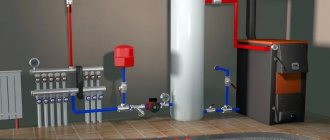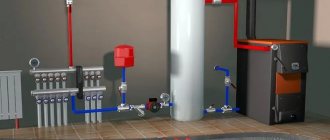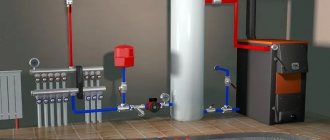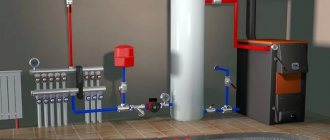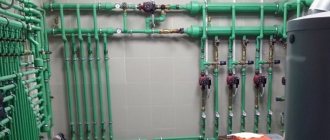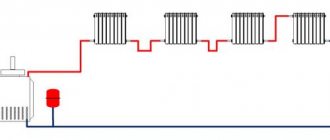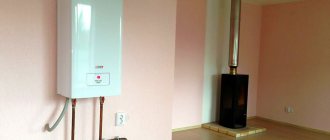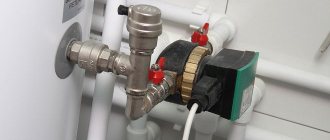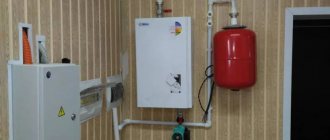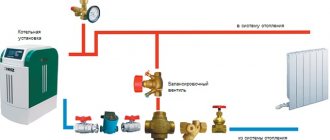Efficient home heating is one of the most important tasks for every homeowner. An interesting solution to this problem could be a steam heating system, the operating principles and design of which differ from the usual water circuits.
This is not the easiest option, and has its own strengths and weaknesses. We will talk about the rules of design and organization, the features of the system with a vapor coolant. You will learn how to install steam heating in a private home and how to operate it correctly.
Features of low pressure systems
A common version of such a system is closed, using gravity return of condensate to the boiler, which does not completely fill the pipes, and an upper pipe distribution is used.
First, the system is filled with water to the required level, after which heating begins. The condensate flows down a common riser and, when a predetermined level is reached, is forced into the boiler.
In the same system with bottom distribution, it is recommended to install pipes with a slight slope in the direction of steam movement in order to reduce noise effects. At the point where the condensate is drained, a loop-shaped water seal is installed, which prevents the movement of steam onto the condensation line.
The steam velocity in such systems should be moderate, no more than 0.14 m/s. Otherwise, the steam will also capture particles of moisture accumulated on the walls. As a result, the system operates with more noise and increases the risk of water hammer.
Combined wiring, i.e. a combination of upper and lower wiring is used if pipes are laid under the floor of the upper or middle floor of the house. The lumen of the pipes through which water returns to the boiler will in this case be closed by condensate.
If the pressure in the system exceeds 0.02 MPa, it should be made open. The air is removed through a condensate storage tank, and to prevent steam from leaving the system, a condensate drain or water seal is installed. Water from the storage tank is pumped into the heat exchanger, which allows the storage tank to be installed below the level at which the heat exchanger is located.
The coolant for heating a private house with a boiler room is heated in a heat exchanger located in the boiler room. Upon reaching the operating temperature, the steam moves to a manifold that divides the flow into two circuits: for the main rooms and for the boiler room (+)
Purpose of the superheater
The device used to increase the saturated steam temperature of a boiler is called a superheater. Its design makes it possible to make the steam temperature higher than the same indicator necessary for its saturation.
During operation, the device is subjected to high loads due to the exposure of its surfaces to high temperatures. The superheater collector heats up to its maximum levels. Superheating of saturated steam significantly increases the efficiency of boiler equipment.
When boiler equipment operates, saturated steam is generated. When moving, the vapor mass partially condenses. To prevent large amounts of water from changing from gaseous to liquid, the steam is heated until it reaches a high temperature.
Assessing advantages and disadvantages
What are the benefits of a steam heating system? It is relatively easy to make even on the basis of a conventional wood stove. This is especially true in areas where there is no centralized gas supply, but firewood or other solid fuel is quite accessible.
Steam is significantly ahead of water as a coolant. Its heating rate is three times higher. In addition, a steam heating system is unlikely to fail during winter cold due to lack of heating.
If the firebox burns out, water from the system will collect in the storage tank or heat exchanger, and the pipes and radiators will remain empty. With water heating, freezing of the coolant, which fills the entire circuit, is known to lead to pipe rupture.
Finally, the dimensions of steam heating radiators should be significantly smaller than for water systems, since the amount of thermal energy obtained as a result increases several times. This will slightly reduce the cost of installing a heating system at home.
Decorative grilles for steam heating radiators are not only an element of interior design, but also a means of protection against burns
This concludes the list of advantages of the steam system, and we can move on to its disadvantages, which are quite significant:
- high risk of burns;
- increased noise level during operation;
- difficulties in adjusting the operation of the system;
- the need to purchase expensive pipes, etc.
Safety standards do not recommend steam heating for residential premises, as it poses a high risk to the health and life of people living in the house.
Thus, the operating temperature of the radiators will be very high, and if you touch them you can get a serious burn. Therefore, all radiators will have to be covered with reliable decorative grilles.
Ordinary PVC pipes are not suitable for such a system, since they must withstand high pressure and temperatures of more than 100 degrees. The same requirements apply to other elements of the system. Steam heating pipes must be copper or galvanized steel.
Copper pipes are an ideal, but not at all cheap, communication option for steam heating systems. To connect these pipes you will need a welding machine
In any case, this moment cannot be called budgetary. Security issues must be given the utmost attention. All installation work, for example, welding copper pipes, will require the highest quality performance. If the connection ruptures and a stream of steam escapes through the hole, one of the occupants of the house risks serious burns.
Stainless steel pipes are able to withstand the loads typical of steam heating systems, such as high temperature and increased pressure in the system
Another disadvantage of steam heating is the increased noise level. To fix this problem, you must install the radiators correctly. They are suspended on special anti-noise brackets. It is best to place the boiler or stove in a separate room. In addition, copper pipes can be placed in the thickness of the walls, which will also reduce the noise level.
Finally, it is a little difficult to regulate the heating temperature in rooms with steam heating. You cannot install a thermostat and simply reduce the amount of steam. You will have to reduce the amount of fuel, which is not always easy, or ventilate the premises. Before starting work on installing a steam heating system, all these points should be taken into account.
Additional boiler elements
The design of a steam boiler is not limited to the basic elements that have already been described above. Sometimes a steam boiler can be equipped with additional devices to increase the efficiency or functionality of the system.
We are talking about the following elements:
- Superheater . This element allows you to heat steam to a temperature of over 100 degrees, which allows you to achieve greater efficiency by increasing the efficiency of the unit. When using a superheater, steam can reach a temperature of 500 degrees, and its heating is carried out already in the pipes, that is, after the stage of evaporation of water. The superheater can be either built-in or in the format of a separate device. There are convection and radiation devices (the second type has 2-3 times more power).
- Steam separator . This element of the steam boiler allows you to remove all excess moisture from the steam and dry it as much as possible. When using a separator, the efficiency of the entire boiler increases significantly.
- Steam accumulator . This device allows you to stabilize the system. The battery absorbs excess steam generated and returns it to the system if it becomes too low.
- Water purification device . This device allows you to reduce the saturation of water with oxygen and various chemicals. Timely water preparation makes it possible to reduce the impact of corrosion on the internal elements of the boiler and minimize the amount of deposits in the system.
The steam boiler device also includes a valve for draining condensate, air heaters and a unit control unit, which includes a combustion switch and regulators for the consumption of raw materials and energy resources. Understanding what a steam boiler consists of allows you to tailor its configuration to solve specific problems.
Design of a steam heating system
Even for a small room, it is best to draw up a project. A system made at random will most likely soon require rework, and a diagram drawn up on paper will allow you to immediately identify weak points and correct them.
For example, in order to create a system with natural coolant circulation, the heat exchanger, and accordingly the heating device, should be located at the lowest point of the house.
The steam and condensate pipelines of heating systems with a natural type of coolant movement are arranged with a slope in the direction of its movement (+)
This means that the stove or boiler must be located below all radiators, as well as pipes that are not vertical, but horizontal or at an angle to the vertical.
If it is not possible to place the heating device in this way (the house does not have a basement, the basement is used for other purposes, etc.), preference should be given to heating with forced circulation.
The diagram shows a heating system with forced circulation. To install it you will need a circulation pump and a storage tank.
Therefore, it is necessary to include a pump in the steam heating circuit that will pump water into the heat exchanger. An important point in designing a heating system is the order in which the radiators are connected. A sequential connection or the so-called one-pipe system involves connecting all radiators in order.
As a result, the coolant will sequentially move through the system, gradually cooling down. This is an economical connection option, which is easier to install and will be cheaper.
But the uniformity of heating with this method will suffer, since the first radiator will be the hottest, and the last coolant will enter in a half-cooled state.
Single-pipe connection of radiators, as can be seen from this diagram, involves sequential installation. The coolant reaches the last radiator already cooled down
A single-pipe solution may only be acceptable when connecting steam heating in a country house or in a small house with an area of less than 80 square meters. m. And for a spacious cottage or two-story building, a two-pipe system in which radiators are connected in parallel is more suitable.
The single-pipe design ensures simultaneous rather than sequential flow of coolant into each radiator, and the rooms are heated more evenly. But with a two-pipe circuit, two pipes will have to be connected to each radiator: direct and return.
Such a system is more difficult to implement, and it will cost a little more than when installing a single-pipe system. However, the vast majority of water heating systems are made according to a two-pipe scheme, despite the difficulties, and function quite successfully.
This diagram shows a two-pipe installation system for steam heating radiators. Each radiator is connected to a common riser and has a return pipe, which ensures uniform distribution of coolant
If you plan to use a wood stove as a heat source, you should immediately calculate and design a special heat exchanger. It looks like a coil welded from metal pipes. This element is built directly into the furnace structure, and is not installed separately.
Therefore, the design of a new furnace should also be considered at the design stage. You can also use an existing stove, but it will have to be partially disassembled in order to install the heat exchanger inside.
To obtain 9 kW of heat, a heat exchanger with a surface area of about one square meter is required. The larger the heated area, the larger the size of the heat exchanger should be.
If you plan to heat the room using a boiler, then everything is a little simpler: you need to buy and install it. Usually, for steam heating in a house, it is recommended to take a water-tube boiler model, as it is the most efficient.
Although fire-tube, smoke-combustion or combined smoke-fire-tube models can also be a completely acceptable option.
Sometimes, to organize steam heating, they use a homemade boiler in which waste engine oil is burned. But this option is considered suitable for use in utility rooms, for example, in a garage. For a residential building, this option is not very good.
Electric boilers
A steam boiler of this type is characterized by:
- ease of operation;
- efficiency;
- environmental friendliness;
- silent operation.
In addition, such a boiler design is much simpler than that of devices using solid or liquid fuel. Electric boilers do not need to be constantly cleaned of ash or slag, and the fuel itself does not require special additional preparation. This way, you will save money that would have been spent on delivering fuel to your home and that would have been spent on installing a fuel storage facility.
According to their design, electric boilers are divided into:
- Direct action devices. They use water as a conductor of electric current, which is heated according to the Joule-Lenz law.
- Indirect action devices. They use, for example, heating elements as heating elements.
However, if we talk about the price of steam boilers of any type, it is quite high. It is this fact that makes some consumers (especially in rural areas) want to create such a device with their own hands. Let's consider whether this is possible in principle?
Installation based on a wood stove
If the project has been drawn up, it’s time to stock up on the necessary materials and tools. A previously drawn up project will allow you to calculate the required number of system elements.
All turns, connections, tees, radiator installation locations, etc. should be marked on it. In addition, it is necessary to purchase pipe clamps, as well as brackets on which the radiators will be installed.
The boiler of the steam heating system, based on a wood-burning stove, is installed directly in it. A steam line and a condensate line are connected to the boiler
The length of the pipes is also calculated according to the diagram. To reduce the steam pressure in the system if necessary, you will need a pressure reducing valve. The hydraulic seal is required to allow the system to be completely drained for cleaning, maintenance or repair.
It is recommended to install a shut-off valve in front of each radiator, which will allow it to be turned off for repair, flushing or replacement. Mayevsky taps are also installed on radiators to release air trapped in the system. Although steam is a gaseous substance and not a liquid, the presence of air in the system can negatively affect its efficiency.
To ensure that the condensation process occurs in the radiators, and not in the storage tank or riser, it is recommended to install a tee with a plug at the outlet through which only water will pass. If you plan to install a system with forced circulation, you will need a circulation pump. In addition, you need a container to collect condensed moisture.
Gravity flow systems do not need such devices. But the pipe that carries the water to the heat exchanger must be wide enough to allow the liquid to move quickly for further heating.
The absence of a pressure reducing valve in the steam heating system, the device of which is shown in the diagram, can lead to serious damage due to excess pressure
In addition to the usual installation tools, you will definitely need a welding machine to connect copper pipes. Galvanized steel structures usually have threaded connections that must be carefully sealed. If you plan to install steam heating from a furnace, you will have to start with the manufacture of a heat exchanger.
A steam heating heat exchanger built into a wood stove consists of a system of hollow metal pipes through which water circulates. The element can have any shape corresponding to the size and shape of the oven
It is made from metal pipes 2.5-3 mm thick or even a little thicker. The heat exchanger can be made either in the form of a coil or in any other form. The main thing is that the device fits inside the wood-burning stove, and also that its surface is large enough to heat the water and generate steam.
The welding quality of the heat exchanger must be, without exaggeration, ideal. Even microscopic cavities in the seams are unacceptable, since the device will be exposed to increased pressure from hot steam. Once the heat exchanger is ready for installation, each weld should be checked.
To do this, first coat all seams with white chalk. After this, one of the heat exchanger holes is closed, and kerosene is poured into the second until the device is filled to the top. Now you need to wait a little and then evaluate the condition of the seams. If there are cracks, kerosene will seep through them, and in such places the chalk will darken.
Identified flaws are corrected, and then the test is repeated to ensure the integrity of the device. Now you should wash it, and then start laying the wood stove. The heat exchanger is securely built into the firebox, and pipes are connected to its inlet and outlet, which are then used to connect the heat exchanger to the heating system of the house.
The laying of the furnace is completed in the usual manner for such structures. Then the installation of pipes and radiators of the heating system is carried out in accordance with the project drawn up earlier. First, radiators are installed, using brackets that will dampen the noise from the operation of steam heating.
Mayevsky taps are installed on each radiator so that air can be released. You will need one more shut-off valves than radiators, since you need to install one common shut-off valve at the very beginning of the system. A pressure reducing valve and a reducing-cooling unit are also installed in front of this tap.
At the end, if provided for by the project, a coolant storage tank and a circulation pump are installed. For systems designed with natural rather than forced circulation, a tank and pump are not needed. But the pipe that leads to the heat exchanger needs to be given a slight slope, about 3 mm per meter.
Modern boilers for steam heating in the house are reliable devices that operate on various fuels and are equipped with automated control systems
Systems with a steam boiler are installed in approximately the same way: in accordance with the design and adjusted for the features of the equipment. For example, a pressure reducing valve and a cooler will most likely not be needed since the steam pressure and temperature control system is already built into the boiler.
Main components
The key component of the system is the boiler. Its main purpose is to convert water into steam. Later it goes into the pipeline.
The boiler must be powerful enough to pull two floors at the same time
The design elements here are:
- pipe system;
- collectors;
- drum.
Steam space
Additional equipment can be installed here. It can be useful if steam separation is required. Intensive exchange between steam and water is the basis of boiler operation. Heating devices are divided into water- and fire-tube. In the latter case, heated gases move in pipe channels arranged in a container of water.
Water tube modifications work on a slightly different principle. Here water moves through channels built inside a chamber with gases. First it heats up, after which it begins to boil. Water moves naturally inside the boiler.
In all types of boilers, the same rule for converting water into steam applies. First, the liquid is carried into a reservoir located in the upper zone of the device. It then flows into the collector and rises into the drum located at the top, moving through the heating area. Steam is formed inside the pipe and goes up. It can move through a separator where it is separated from the liquid. Then it goes into the steam pipeline.
Heating can be easily installed with your own hands
The boiler can use various fuel options. In accordance with these features, the design can be modified. Changes may also affect the type of operation of the combustion chamber. Let's say a grate is required for those cases where solid fuel is used. At the same time, special burners will be needed if the fuel is gaseous or liquid. Mixed options are more convenient and practical.
Radiators and pipe system
Temperature indicators in the steam system are within +100…+130°C. Compared to water ones, they are much taller. That is why it is not recommended to use similar equipment for arranging systems. This applies to pipes made of polypropylene and metal-plastic. The maximum performance indicators of these materials are within +90…+100°C; their use is strictly prohibited.
Condensation formed inside the parts leads to rapid destruction of the pipe material. We must not forget that steel is not resistant to corrosion. The aggressive coolant environment enhances this disadvantage. The connection requires welding, which requires a lot of time and labor. It is better to take galvanized steel pipes. These products withstand elevated temperatures and require the use of a threaded connection method. This approach greatly simplifies the workflow. The only thing that can serve as an obstacle to purchasing such products is their high price.
Another ideal option is copper pipes. The material is plastic, not afraid of thermal influences, durable, and not subject to corrosion. Soldering is used to connect copper components. Copper piping is durable, but expensive.
Some useful tips
When installing a steam heating system, you should remember that all its elements must withstand high temperatures, more than 100 degrees. For example, a regular membrane expander will not work as a reserve tank in case of an increase in coolant volume, because its maximum is 85 degrees.
The chimney of a stove with a built-in heat exchanger will become dirty faster than that of a conventional stove. Therefore, chimney cleaning needs to be planned and performed more often.
If desired, an oven with a heat exchanger can also be used for cooking, but this is not very convenient. In summer, when heating is not needed, this stove cannot be lit. We'll have to look for an alternative. It’s easier if there is a separate, convenient stove for the kitchen in the house.
How to design and assemble a steam heating system with your own hands is described in detail in this article, which we recommend for reading.
Superheater calculation
Carrying out calculations can be constructive or verification. In the first case, calculations are carried out before manufacturing a new boiler. In the second situation, the calculation is carried out during the operation of the equipment.
Calculation of the first convective stage along the gas flow. Photo source: studopedia.info
This takes into account the location of the device, the temperature of the steam and exhaust gases, the method of adjusting overheating and other factors. A boiler superheater is necessary to heat the steam mass to a higher temperature. Its presence allows you to increase the efficiency of boiler equipment.
Depending on the design of the devices, their technical characteristics differ.
Some people call a steam iron a steam generator.
So, let's start with the simplest and most well-known device: a steam iron. Despite such a loud name, at its core it is an ordinary iron with the ability to turn on the steam mode. This design has been known to everyone for a long time. Of course, irons of this type have undergone some changes both in design and functionality, but they remained a tool of manual labor and remain so.
What are the benefits of a steam iron?
One of the advantages of an iron with a steaming effect is a huge selection of models, both in design and price range.
Another advantage is the mobility of this device. You can iron or steam things anywhere at any time. By purchasing a small-sized iron model, you can take it on trips.
The versatility of the device. Sometimes a housewife has to deal with things that are difficult to iron (ironed folds, overdried laundry, thick fabric) - here the steaming effect will come to the rescue. The ironing process is greatly simplified thanks to the possibility of a burst of steam and humidification.
Iron with steam generator
Models come with a built-in generator and a free-standing one. For devices with a free-standing steam generator, the supply system is connected using wires and steam-conducting hoses.
Device
The product is equipped with a special station with a heating element and a water tank. The hot air flow is supplied through a special hose. The main role here is assigned to the steam station, where heating occurs to the specified values. Its structure is as follows:
- water container;
- heating element (heating element);
- thermostat;
- fuse;
- pressure regulation toggle switch;
- cover to protect the safety valve;
- the valve itself;
- dispenser;
- pressure gauges (in some models).
We list the main elements of the entire structure:
- The back cover is secured with screws to the body. Sometimes it is attached to a block, in this case the cover is straight. If it is not secured to the block, then when disassembling the cover must be pulled up. The latches release the fasteners.
- The block secures the cable in the housing. Can be monolithic or collapsible. The monolithic one can be removed by unscrewing the screws on the block and clamp. To remove the collapsible block, you need to release the latches.
- The top cover is secured with special devices with squeezers. Removal from both sides is provided.
- The housing is screwed to the steam station with recessed fasteners. They differ in shape and length.
- The sole contains conductive and heating elements.
By type, steam stations are divided into gravity and pump. First, the liquid gets to where the heating element is located. There, at high degrees, the liquid evaporates. In pump pumps, water is heated directly in a separate container. After steam generation, hot air under high pressure is supplied to the sole.
If you need to iron a small amount of laundry and there are no high demands on the result, gravity-fed products are suitable. If you need to have perfectly ironed items, it is better to use a pump model.
Principle of operation
To ensure proper functioning of the steam station, you must perform the following steps:
- unscrew the valve cover;
- fill the container with water;
- connect the station to the network (voltage 220V);
- turn on the heating element button on the panel to start heating the water to 160 degrees.
The operating principle of an iron with a steam generator is a whole system of supplying hot air without heating the sole. When the specified values are reached, the water turns into steam. Pressure within 0.35 MPa. After 150 seconds the system is ready for use. The models provide overheating protection; these functions are provided by a thermostat and a fuse. If the steam mode exceeds the standard values, the heating element automatically turns off. When the degrees drop, the heating automatically turns on. If the thermostat breaks down, the fuse ensures safe operation. If it burns out, the entire circuit shuts down. After replacing the fuse, you can continue to use the device.
Electrical diagram
The circuit of an electric iron with a steam generator consists of the following parts:
- Euro plugs with grounding;
- relay KM - with winding power circuits;
- SK – position sensor;
- thermostat;
- connection block;
- thermal protection;
- heating element;
- indicator lamps.
The position sensor with the KM relay performs protection functions. There is also an LED power indicator.
Ideal boiler
Knowing these features, one can imagine from the standpoint of today how a certain ideal steam boiler should be constructed. In fact, it will turn out to be very expensive and difficult to maintain, and in the “golden age” of steam, such a boiler was technically impossible. The entire evolution of boiler construction has followed the path of simplifying the equipment (piping) of the boiler and combining the functions of its systems. But this diagram will help you figure out what the boiler needs for normal operation.
A general diagram of the structure of a steam boiler is shown in Fig.:
Generalized diagram of a steam boiler
The steam generator is a channel (tubular) gas-water heat exchanger. An increase in the contact area of the coolant with the heater enhances the formation of microbubbles of steam in its mass and the separation of steam from a unit area of the heater at the same temperature. In a steam tank, pure steam and a water micro-suspension are separated by gravity or absorption without releasing the latent heat of condensation. The hot condensate flows back into the steam generator or, in circulation boilers (see below), is pumped into it by a circulation pump.
The role of the superheater is very important. Without a pressure drop along the length of the steam line, there will be no steam flow through it, but at the same time the strength of the steam decreases and the likelihood of its violent condensation increases. The superheater “pumps up” the exhaust steam with energy for free - due to the residual heat of the flue gases.
The economizer further increases the thermal efficiency of the boiler. This is also a channel heat exchanger, in which the feed water is also heated with flue gases. At the lowest boiler speed, the economizer can become overcooled and become overgrown with soot, and when the boiler is boosted, it can overheat and even boil. Therefore, sometimes a separate water circulation circuit with a water elevator, similar to those used in single-circuit CO systems (see above), is introduced into the economizer. During normal operation of the boiler, the economizer's own circulation is cut off by a shut-off valve.
The last thing that allows you to “extend” the thermal efficiency of the boiler to the theoretical limit is heating the air entering the firebox. In high-power thermal devices this is a very effective measure. At one time, heating the air in cowpers made it possible to reduce fuel consumption for blast furnaces by almost three times. As for the control unit (or device) for all this equipment, now it is a box or cabinet with a microprocessor and its electromechanical wiring, and in the old days it was a team of a driver and a fireman.
How does a steam generator work?
Before starting work, it is necessary to pour water into the tank: preferably purified, as this will significantly reduce the amount of plaque buildup. It will take about ten minutes to heat the water. Under pressure, steam flows through the hose to the iron, through the holes of which it flows out to the surface being treated.
When used correctly, the steam generator is safe. When the steam overheats, the thermostat “turns off” the heating element; if it breaks, this function is transferred to a fuse that opens the circuit (the device is completely turned off). But despite a good protection system, it is better not to leave a steam generator connected to the network unattended.
